
December 22, 2009
 CR Holiday Interview #3—Bart Beaty On Persepolis
CR Holiday Interview #3—Bart Beaty On Persepolis


What would I do without
Bart Beaty? Recruiting Beaty to write "Euro-Comics For Beginners" at
The Comics Journal was the smartest move I made at that job, and accepting his offer to pen "
Conversational Euro-Comics" for
The Comics Reporter is my best move to date at this one. Sensing a temporary moment of uncertainty regarding which European book might be best suited for a short chat like this one, I fairly bullied the college professor into talking about
Marjane Satrapi's
Persepolis. I did so because 1) that was an obvious important book this decade and 2) I was unclear as to how it was received in Europe before it showed up over here. As is always the case, Bart speaks with the clear authority of someone that knows their field. I'm grateful for his insight. -- Tom Spurgeon
*****
TOM SPURGEON: Bart, this may be kind of a stupid question to start things off, but in general, how does new work get published in Europe? Is it slush piles and mini-comics and convention portfolio reviews like it is here, or do houses like L'Association seek out new books in a different fashion?
BART BEATY: My sense -- and I might be completely off base here -- is that editors are a lot more involved in the recruiting process in French comics than they have traditionally been in American comics. This seems to be changing now in the US as well, where I imagine that
Fantagraphics and
Drawn and Quarterly and particularly
Pantheon are moving more towards recruiting artists. When I talk to European cartoonists I get a sense that they actively pitch work to multiple publishers looking for the best home, and the best known editors seek out promising artists. I think it's significant that when
Soleil/Gallimard relaunched
Futuropolis what we knew about the line was the name of the editor:
Sebastien Gnaedig.
I don't get the sense that there are a lot of portfolio reviews in Europe in the way that there are in the US. Rather, connections between artist and publisher seem to arise more organically, through recommendations and other relationships.
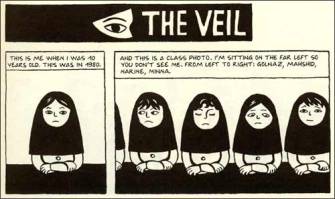 SPURGEON: How did
SPURGEON: How did Persepolis
end up at L'Association? Was Marjane Satrapi a known quantity at all?
BEATY: Marjane and L'Asso are actually a great example of what I'm trying to get at. Satrapi was not originally a comics artist, but a children's book illustrator who shared space at the Atelier des Vosges in Paris. At various times in its history, that work space was shared by some combination of
Emile Bravo,
Lewis Trondheim,
Christophe Blain,
Joann Sfar,
David B.,
Emmanuel Guibert, Marjane Satrapi, and several others. If you made a list of the ten most important French cartoonists of the past decade, you'd put all of those names on the list, and they all worked together.
When Satrapi entered the Atelier, she didn't know much about comics, and she didn't do comics. But working across from these guys rubbed off, and they encouraged her to give it a try. I believe that her first published work in comics was "The Veil" (which is the first chapter of
Persepolis), which was published in
Lapin, the magazine that David B. and Trondheim were co-editors of. So they brought her into comics and into L'Asso at the same time.
SPURGEON: How did readers and critics react to the first volume upon its publication? Was there any reaction to the obvious visual debt she owes David B.?
BEATY: I don't recall a huge reaction to the first volume at the time. I don't even remember buying it or having it given to me, so it can't have made much of an impression at the time (I likely got it at the 2001
Angouleme Festival based on when it was published). Some of the work had been in Lapin, and it was common for L'Asso to collect work from
Lapin and to try to develop an audience for it.
Lapin didn't pay page rates, so it was important to get the material into a book if the author was to be paid. So this just sort of seemed like it was a continuation of typical L'Asso procedures.
The debt to David B. was obvious to everyone -- and
L'Ascension du Haut-Mal was just about the most noteworthy thing L'Asso was publishing at the time. It was akin to Fantagraphics publishing work that looked like
Chris Ware and focused on a lonely man, in that the comparison was unavoidable. Of course, the fact was that David taught her a lot of craft, they worked closely together, and he wrote the introduction to the first volume. They weren't trying to hide anything, and I think a lot of people saw him as her aesthetic father.
 SPURGEON: At what point and for what reason, if this is knowledge that anyone could really know, did it begin to build momentum and become a hit?
SPURGEON: At what point and for what reason, if this is knowledge that anyone could really know, did it begin to build momentum and become a hit?
BEATY: My sense that it was going to be a huge hit came with the third volume (the first half of what would be the second US volume), which was serialized in
Liberation -- a major French daily.
Liberation has serialized a lot of comics over the years -- generally in the summer -- but they tended to be from well-established names like
Jean Van Hamme. This put her entire work in the hands of millions of readers on a daily basis. And the subject of that volume -- her time in Austria as an Iranian emigre -- is really compelling. It was the perfect chapter in terms of content to reach that mass audience, and it is also appeared at a time when her work was no longer tentative.
I remember I included Vol. 3 on my
TCJ "Best of the Year" list that year, with a real sense that now the series was really going places. In retrospect, I should have ranked it higher...
SPURGEON: What is your general appraisal of the work, Bart? Has it changed over the years? Did it change when subsequent volumes are published?
BEATY: I was only lukewarm on the first two volumes. I was intrigued by the end of the second, and blown away by the entirety of the third. Now when I read it as a whole I'm constantly impressed by it. I've taught the book to university students half a dozen times, and they are always amazed by it, and I find I like a work the more that I teach it. I've gotten to the point where I prefer teaching it to
Maus, actually. So I like it a lot.
There are other French comics of the past decade that I think do things better formally, or are smarter, or funnier, or more insightful, or more exciting. But I think
Persepolis is a landmark work and a tremendous achievement.
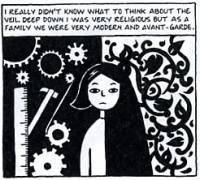 SPURGEON: I saw Marjane Satrapi speak at a Book Expo on a panel with I believe Joe Sacco and maybe Doug TenNapel. At dinner that night we were all talking with some enthusiasm about how obviously charismatic and articulate and funny she was. I remember someone making a comparison with Art Spiegelman in that she shares with Art an ability to talk about comics in an exciting and engaging way. How much do you think the force of Satrapi's personality has had an effect on how her work has been received and processed? Is that important at all in European comics generally? Do people process, say, Lewis Trondheim's work through their conception of Trondheim?
SPURGEON: I saw Marjane Satrapi speak at a Book Expo on a panel with I believe Joe Sacco and maybe Doug TenNapel. At dinner that night we were all talking with some enthusiasm about how obviously charismatic and articulate and funny she was. I remember someone making a comparison with Art Spiegelman in that she shares with Art an ability to talk about comics in an exciting and engaging way. How much do you think the force of Satrapi's personality has had an effect on how her work has been received and processed? Is that important at all in European comics generally? Do people process, say, Lewis Trondheim's work through their conception of Trondheim?
BEATY: She has a very different image than Trondheim, who is much more reclusive and not a fan of the type of press work that she does so effortlessly.
Yes, I think generally that it is the case that writers or artists who are as charismatic as Satrapi have a much easier time. They charm readers, they charm journalists, they charm booksellers, they charm publishers and editors. You can go a long way on charm.
I recall the first book reading I ever attended, I was in high school and went to see a double bill of
Martin Amis and
Michael Ondaatje at Toronto Harborfront. Amis read first as Ondaatje was the home town man. He was mesmerizing -- so witty and charming and British and happy to be there. Ondaatje could barely follow the spectacle, as he can be a bit reserved in these settings. I was utterly amazed by Amis at the time. Now, however, 20 years later, I recognize that Ondaatje is ten times the writer that Amis is (though
London Fields remains a good novel). The fact is, in the end, all the reader will be left with is the work. If the work is there, it will be remembered long after everyone who was charmed by the charmers have passed on to the grave. In this case, and in Spiegelman's, it is the combination of an outgoing enthusiasm for the work and the high quality of the work itself, that have given them the reputations that they have.
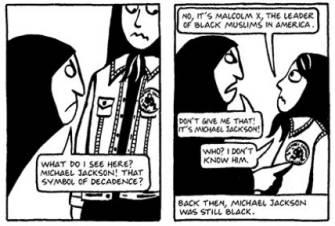 SPURGEON: To focus and/or revisit that question in a couple of ways: I've seen some criticism of
SPURGEON: To focus and/or revisit that question in a couple of ways: I've seen some criticism of Persepolis
saying that the book and Satrapi herself flatter a particular self-conception of Europeans. Is that a legitimate avenue for criticism, do you think? Also, has there been any real backlash against the cartoonist more severe than that kind of sniping? Against the book generally?
BEATY: Persepolis is a book that seems to generate a lot of sniping first and foremost from the "craft boys" -- they're almost always boys -- who say that it is inelegantly drawn. That's the major source of condemnation. Even now, I imagine a number of your readers who haven't read this far because they can't imagine a book drawn like "that" deserving this much discussion. This was even more the case when Embroideries was translated without the suggestion that it was a somewhat dashed-off comic from her sketchbook.
I haven't seen much of the other criticism that you suggest, though I know where you're going. There is some sense that Satrapi is a success because of what she represents: that she is the perfect artist for a point in history when the West is grappling with its relationship to the Muslim world, and to Iran in particular; the perfect artist for a France that banned the veil in schools, and so on. If Marjane Satrapi did not exist, the French press might have had to invent her.
I think that the political reading of Satrapi over here is often different than it is in France, because the issues -- while similar -- are culturally different. Satrapi has been bemused by the fact that she wrote a book that is anti-veil and then became a spokesperson for the anti-anti-veil movement in France. She really tries hard to straddle her Iranian and European identities in a way that complicates the notion that she is simply flattering Europeans, so I don't think that the situation is so simple.
 SPURGEON: What has the book's success meant for L'Association? What effect has it had on that industry generally, do you think?
SPURGEON: What has the book's success meant for L'Association? What effect has it had on that industry generally, do you think?
BEATY: For L'Asso it is similar to
Peanuts for Fantagraphics -- it saved their ass. I'm not sure if L'Asso would be where it is today without
Persepolis, and its success has allowed them to underwrite a lot of work that they otherwise probably could not have taken on. L'Asso still publishes a lot more "unsellable" work than any publisher I can think of. They really truly publish work for which there is very little established audience, and they take much bigger risks than even the big risk takers over here.
Persepolis has meant that they could more of that, though they'd probably do it anyway.
I also think that Satrapi's decision to stay with L'Asso is enormous. After
Persepolis she could have published anywhere, and probably for a huge advance. I know what the advances are for some artists who have sold 1/20th what she sells, so I can imagine some people offered her dumptrucks filled with Euros. And she turned them down. She said, essentially, "L'Asso believed in me when none of the rest of you would give me a look; that's why I believe in L'Asso." That's really amazing when you think of it, that kind of loyalty. There are a lot of American cartoonists who have abandoned the publishers that gave them a break for a lot less.
In terms of the industry, her success really cemented a desire to find the next great graphic novelist. The French industry is no different from the American: look and see what sells, try to find 100 more of those.
 SPURGEON: Certainly the movie had some effect on the way some audiences look at the book. For instance, I thought the movie's look was nearly luminous, and I think I looked upon the book's art with a kinder eye for having seen this more sumptuous version. I know how American audience look at film adaptations and have an inkling on the close relationship between manga and anime, but how does that relationship work in Europe? Do people make strong distinctions between the two, or in this case was there some respect afforded the fact that she was closely involved?
SPURGEON: Certainly the movie had some effect on the way some audiences look at the book. For instance, I thought the movie's look was nearly luminous, and I think I looked upon the book's art with a kinder eye for having seen this more sumptuous version. I know how American audience look at film adaptations and have an inkling on the close relationship between manga and anime, but how does that relationship work in Europe? Do people make strong distinctions between the two, or in this case was there some respect afforded the fact that she was closely involved?
BEATY: I find it interesting already that when I teach the book one of the reactions I get from students is: "Hey, did you know that they made a movie about this?" Despite the success of film with critics and as a winner of awards, it was a bomb on this side of the Atlantic. I just looked it up and saw that it did less than $5 million in North American box office. I would guess that more Americans have actually read the book than seen the film, which is an unusual inversion of these kinds of relationships. I think that the film is really interesting in its own way and wish it had done better than it did.
It's funny that you bring up the look of the book and of the film, and the differences there. I'm one of the people that thinks the book looks phenomenal and wouldn't change a thing about it. One of the things that I like is that the drawing gets "better" -- that is, looser, more fluid, more refined and more confident -- as the story progresses. This strikes me as perfectly apt, since the book is about growing up. To that end, I think that the changes over time in the look of the book contribute gradually, sometimes almost imperceptibly, to the central theme of the work as a whole. That's a real strength of the work.
The film, on the other hand, is much "slicker" and more consistent throughout the piece as a whole. This gives the work a very different feeling in my mind, and moves it away from one of the things that I liked about the source material. To an extent this is countered by the exemplary voice work of Gabrielle Benites and Chiara Mastroianni in the film, as they are able to communicate with their performances much of what falls to the drawings in the book.
 SPURGEON: Were there books other than Satrapi's that kind of built on an alt-comics memoir tradition exemplified by
SPURGEON: Were there books other than Satrapi's that kind of built on an alt-comics memoir tradition exemplified by L'Ascencion du haut mal
? Are there baby Satrapis out there?
BEATY: There are a lot. Like in the US, autobiographical comics is a defining alt-comics genre -- perhaps the defining genre. To that end there are entire publishers in France that are predominantly associated with autobiographical comics, like
Ego Comme X. At the same time, I'm not sure if any of these people are really poised for the next huge explosion. I've been pushing the work of
Fabrice Neaud as the best comics autobiography and memoir work going for what seems like the better part of a decade, but I've never found a publisher who wanted to take a crack at publishing it.
SPURGEON: When we were sussing out the book about which I was going to ask you questions, you said it was more difficult to figure out the books of the '00s as opposed to the books of the '90s. Can you mention a few books that you think were specifically important to this decade and why?
BEATY: When I was writing
Unpopular Culture, which specifically deals only with the 1990s, I had a sense that there was a real revolution in the air in European comics, with presses like L'Association and
Amok and Freon at the forefront of something really exciting. I don't feel that anymore. Some of the people I thought were leading lights of that revolution have left comics, some have curtailed their revolutionary fervor, and some went on to become president at Angouleme and are now the new grand old men of comics (though they'd hate to be considered that way). In the 1990s there was a feeling that the orthodoxies of the 1980s, which was an era of retrenchment in French comics complete with a market collapse, had to be smashed. They were smashed, but the now there are no orthodoxies against which to rebel. The field is very open, so some of the excitement has dissipated.
That isn't to say that talent is gone. The 2000s have seen the emergence of some remarkable talents in comics. To name only a few:
Florent Ruppert and Jerome Mulot are doing the most fascinating work in comics today -- they should be superstars.
Riad Sattouf had an amazing decade as a cartoonist and has moved now into film with great results.
Winshluss, Satrapi's co-director on
Persepolis, has emerged as an incredible talent and a grand humorist.
Ludovic Debeurme continues to astound me with everything that he releases, and has an amazing ability to keep shifting gears.
Frederik Peeters could make a convincing claim to most significant new talent of the decade.
Dominique Goblet released two of the best books of the decade with
Souvenir d'une journee parfaite and
Faire semblant c'est mentir. And, of course, I think
Gipi has been one of the most significant revelations of the decade even though he is older than the other names I've just mentioned. One of the great things about this decade is that I could list 50 more names here -- this is just the tip of the iceberg. Emmanuel Guibert! Most of his important works are from this decade, and he's on an incredible creative roll. My apologies to everyone I'm leaving out.
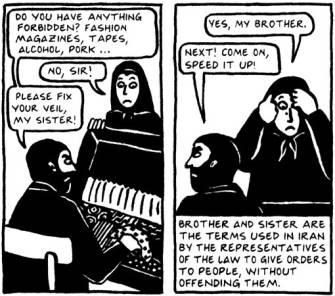 SPURGEON: One thing I found lacking in the English-language reviews was a discussion of
SPURGEON: One thing I found lacking in the English-language reviews was a discussion of Persepolis
as a book of ideas: what exactly she was saying about her experience above its general orientation, the novelty of it, and some of the pleasing, funnier, smaller moments. The older Marjane in particular, looking for a place to belong, does that material get read in a different fashion in Europe than in the US, where a lot of this border crossing and personal orientation seems exotic?
BEATY: I'm not sure that the reviews have been significantly smarter in Europe than in North America really, though I do think that Satrapi's interviews and statements have had the effect of contextualizing her voice in Europe much more than over here. She's remarkably "out there" in the public eye and she speaks her mind, so there is a much fuller context for reading her work just by virtue of that fact.
That said, I've found that that struggle of the adult Marjane to find a place to belong is the element that most resonates with a good deal of my students. Perhaps this is a function of teaching in Calgary, which is one of the fastest growing urban centers in North America and consequently home to a lot of immigrants, but border crossing is one of the pre-eminent issues for the 20 year olds that I'm in contact with every day. I think a lot of them read the third part of
Persepolis with a "there but for the grace of God" feeling, and absolutely relate to the fourth and final part. A huge percentage of my students coming from south-east Asia and Africa feel that
Persepolis is speaking directly to their day to day concerns in an increasingly globalized world.
 SPURGEON: It's hard for me to imagine anyone having a fruitful career of a certain type with this big a book being published up front? What's your general appraisal of the post-
SPURGEON: It's hard for me to imagine anyone having a fruitful career of a certain type with this big a book being published up front? What's your general appraisal of the post-Persepolis
works? Do you expect her to continue in comics?
BEATY: I adored
Chicken with Plums, her first real work of fiction. In some ways I thought it was better than
Persepolis, although I'm apparently in the minority on that over here. The book did
win the prize for Best Comic at Angouleme, so the French liked it at least. As to whether she'll come back to comics, that's hard to say. She's working right now on a live-action film version of
Chicken with Plums (co-directed, as with
Persepolis, with Vincent Parronnaud) so it's entirely possible that the world of cinema could swallow her up. If I were to merely guess, I could imagine her having a remarkably
Jules Feifferesque career: shifting between comics, film, novels, children's books, and theatre. I'm sure that she has many more opportunities before her right now than she could possibly handle.
SPURGEON: Is Persepolis
a book to which you think people will return, and if so, what do you they'll be looking for? What is your takeaway?
BEATY: In many ways I see it as a very affirming story. The first volume of
Persepolis was published in October 2000. The one millionth copy of
Persepolis was sold in 2006. That's frankly astounding to me, that a black and white autobiographical first comic from a small press like L'Association, which has virtually no advertising infrastructure, could achieve that. It's an amazing story about the ability of an artist to connect with an audience outside of the hype market that drives so much of our current best-seller culture in a post-Rowling, post-Dan Brown mediascape.
As for whether or not people will continue to seek this book out, absolutely I believe they will. I think
Persepolis is a sure keeper to the same degree that
Maus is now. I was recently on a PhD examination committee in a Literature Department and I was provided with the lists of books that the student had to read in various areas to prove competency.
Persepolis was on the list for Women's Writing, alongside
Toni Morrison and
Mary Shelley. My first thought was "that's quick," but the book also didn't look that out of place in the context that it had been placed. This is a book that is going to continue to be written about, talked about and taught to students. If anything, we're still only at the very beginning of Satrapi's fame.
*****
*
The Complete Persepolis, Marjane Satrapi, Pantheon, softcover, 9780375714832, 352 pages, 2007, $24.95
*****
* all images from the
Persepolis volumes, I believe, except for the elephant sequence which comes from
Chicken With Plums. I'm not 100 percent sure where the bottom image came from other than the fact it was on my hard drive for some reason. It might be worth noting that the two images at top are of the initial Pantheon English-language releases while the book with the number 3 on it is the third in the L'Association French-language releases that Bart talks about reading. At least I hope.
*****
This year's CR Holiday Interview Series features some of the best writers about comics talking about emblematic -- by which we mean favorite, representative or just plain great -- books from the ten-year period 2000-2009. The writer provides a short list of books, comics or series they believe qualify; I pick one from their list that sounds interesting to me and we talk about it. It's been a long, rough and fascinating decade. Our hope is that this series will entertain from interview to interview but also remind all of us what a remarkable time it has been and continues to be for comics as an art form. We wish you the happiest of holidays no matter how you worship or choose not to. Thank you so much for reading
The Comics Reporter.
*
CR Holiday Interview One: Sean T. Collins On Blankets
*
CR Holiday Interview Two: Frank Santoro On Multiforce
*****
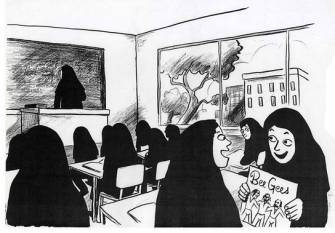
*****
*****
posted 2:00 am PST |
Permalink
Daily Blog Archives
November 2019
October 2019
September 2019
August 2019
July 2019
Full Archives


